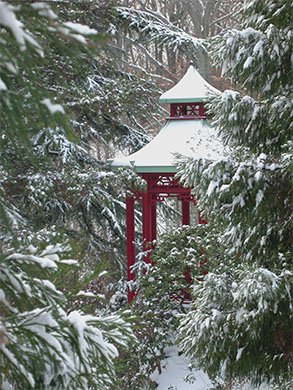Do those vacation dates seem far away? Or perhaps you’re wishing there was a vacation on your calendar. If cabin fever is setting in, I may be able to help. Grab your mittens, scarf, and boots! Just inside Washington, D.C., you’ll find our National Arboretum; 446 acres of trees, shrubs, and in the warm months, flowers and gardens designed to showcase rare and exotic plants. All this, free of charge, any day of the week. Take an easy drive due west and you and your companions
brcan enjoy almost 10 miles of winding roads, dramatic vistas, and intriguing gardens on the edge of a great city.
Whatever sort of garden interests you, you may find new inspiration at the Arboretum, which encompasses fourteen named garden areas. Since it’s winter, I suggest focusing on the Gotelli Conifer Collection, the Asian Collection, and the National Bonsai & Penjing Museum. Those three collections can consume a day, or even two, of sightseeing. Save the azalea-covered hillsides and the holly and magnolia collections for spring.
In Italian Villas & Their Gardens, American novelist, Edith Wharton wrote admiringly of the gardens surrounding Tuscany’s elegant, country villas. Wharton adhered to “that principle of old gardening…namely, the subdivision of space.” At the National Arboretum you can experience for
bryourself similar, old-world, petitioned garden spaces. For a sense of the effect of these discreet gardens, park your car at one of the hilltops in the Arboretum. Get out and look east, over the bare treetops of the Asian Collections, see the Anacostia River, wide and meandering at the Arboretum’s border. Look south, and west, past magnolias, lakes, and meadows, toward our Capital’s landmark domes and obelisks. Look north, and rest your gaze on nature’s dramatic evergreens in the Gotelli Conifers Collection—the pines and firs, the redwoods and cypress.
I recommend beginning your exploration with those conifers; they’re particularly lovely in winter’s austere landscape. Their grace and elegance add gravitas to a landscape. The National Arboretum has seven acres of evergreens, both rare and familiar, in their collection. The variety of colors and shapes is astounding, and those variances are particularly impressive in the winter, when deciduous trees are gray silhouettes.

One of my favorite spots in the Arboretum is the grove of dawn redwoods (Metasequoia glyptostroboides) as you approach the Gotelli Conifer Collection. According to the Arboretum’s historians, until 1940 dawn redwoods were thought to be extinct. A grove of these magnificent
brtrees was discovered in a remote region of China. Seeds were shared with botanists around the world, and this grove of five are American daughters of those Chinese trees. They’re among the Arboretum’s rare, prized specimens.
And if you enjoy rarities, look for a magnificent weeping blue atlas cedar—very elegant and exotic in appearance. The Cedrus atlantica ‘Glauca’ is a good candidate for your garden. She tolerates urban pollution and likes to be protected from strong wind. She’s not picky about her soil, but needs sunshine to partial shade, and only grows about 12 inches a year. (You can look at pictures of many of the specimens on the National Arboretum’s website.)
Note to Gardeners: Once evergreens root, the trees are comparatively low maintenance. You may already have one or two in your garden. If you do, you know that they demand careful placement and patience, since most conifers grow slowly. (Dawn redwoods are the exception; they’re relatively fast growing.) You may be a bit chilled by the time you’ve wandered among the conifers, so I’d suggest a visit to the sunny, protected, rooms of the Bonsai & Penjing Museum in the heart of the Arboretum. While you may not have the temperament or the time to create and maintain your own bonsai or penjing, I suspect you will find these miniature trees on their miniature islands or mountainsides, amazing. And, if you’re bringing children they will be fascinated by these tiny worlds of rock and trees.

Both bonsai, a Japanese art, and Chinese penjing are ancient landscape miniaturization hobbies. Contemplation for the viewer and patient persistence for the creator are the focus of both bonsai and penjing. Japanese bonsai limits the tiny contained garden to trees, shrubs, and rocks; occasionally driftwood will be added. Japanese traditional presentation often includes viewing stones, beautiful rocks, or boulders chosen for their fossils or unusual veins of crystal. Chinese penjing adds to the miniaturized trees ceramic figures and even tiny huts and boats, shrubs, and rocks. A penjing offers a glimpse into a magic, ancient world. Two of the stars of the museum are the 400-year-old, bonsai, white pine that began training in 1625, and the world renowned Goshin, or Spirit Garden, made up of eleven trees trained by an American, John Yoshio Naka. Find a sunny bench out of the wind, sit, and enjoy these beautiful creations.
So, fellow gardeners and garden-lovers, whether it’s a blustery day with snow blowing across the driveway or one of those days when pale sunshine gives us hope that spring will arrive before too long, hop in your car and head west to the National Arboretum in the District of Columbia for an infusion of nature’s beauty.